Choosing the Best Type of Paper for Your Print
If you are considering buying a print from my website, but are not sure how to choose, this post is for you.
PRINTSPAPER TYPESMUG MUG PRINT OPTIONS
Annette Jones
2/12/20246 min read
I am frequently asked by interested buyers what type of paper to choose for prints. In this post, I'll explain the available options and recommend how to make a selection.
My gallery is hosted on an image sharing service, Smug Mug. Smug Mug partners with Bay Photo for printing orders within the United States. Smug Mug/Bay Photo have multiple options to consider for prints. While I love how easy Smug Mug made it to start a website and sell prints, I do wish they made more information readily available on how to choose. But not to worry; I've done the research and evaluated the different types to make the selection process easier for you. If you are a print buyer or another landscape photographer evaluating paper options on Smug Mug, this blog is for you.
Recommendations
TLDR: Here is what I would recommend for Fine Art Print and Paper Print choices. First, evaluate if the image you want is brightly colored or more neutral in color. Then select based on what is most important to you.
I have a BRIGHTLY COLORED image, and I primarily want:
vibrant colors with a glossy finish: Epson Premium Luster
vibrant colors with sturdier paper and a subtle sheen: Epson Exhibition Fiber
print longevity with a matte finish, slightly muted colors: Canson Rag Photographique
I have a NEUTRAL COLOR image, and I want:
paper with no texture: Canson Rag Photographique
medium texture, like water color paper: Breathing Color Elegance Velvet
Cost is most important to me, or my image has Unique Dimensions
In this case I would recommend Paper Prints rather than Fine Art Prints.
Paper prints are less expensive than fine art prints and encompass a broader rage of dimensions
Glossy will have the brightest colors
Lustre is a better choice for finger print resistance and reducing glare
Pearl has a glossy finish with an almost metallic shimmer that makes highlights and colors pop
If you're happy with that, you can stop here and make your selection. If you'd like more information, continue reading.
The Details
Being an engineer, I could not complete a comparison without a table.


This table lists some of the most important attributes of Fine Art Paper available on Smug Mug. The table format is helpful to compare each side by side, and to group the papers by how appropriate they are for bright or neutral colors. You may have noticed that two of the papers I did not recommend at all. Below I'll go into the details so you can understand how I made my selections and how to make your own choices in paper. Come back to the table and reference as needed.
Look and Feel
The surface finish, texture, material, and weight of the paper are all things to consider when making a selection.
A surface finish that is reflective or has a subtle sheen will have more vibrant colors and deeper blacks; the downside is glare and showing fingerprints. A matte finish eliminates the glare, but colors and blacks will be more muted.
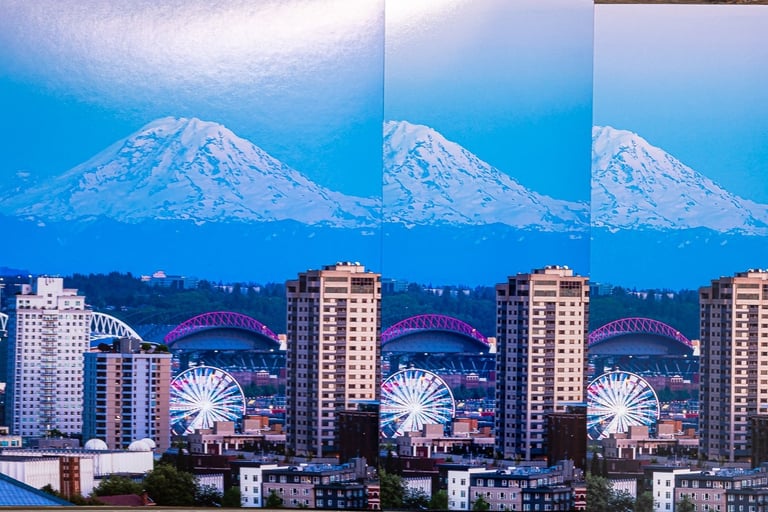

The material and weight of the paper contribute to how the print will feel in you hand and if it will lay flat. Ability to lay flat and feel may be less important if you plan to put it behind a frame. However, if a higher quality feel is important to you, the 100% cotton papers do have a noticeably more luxurious quality. They lay flat and have a noticeably higher weight than RC (resin coated) paper.
The texture is a matter of preference. I can say after evaluating each paper that light/very light texture takes a lot of scrutiny and side by side comparison to notice. The medium texture of Breathing Color Elegance is noticeable in both look and feel. It is comparable to water color paper.
Glare shown on Epson Exhibition Fiber and Epson Premium Luster (left) as compared to Canson Rag Photographique (right)

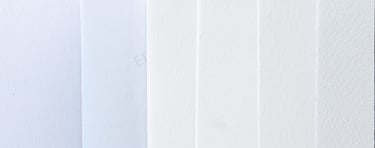
Paper Textures. Left to Right: Epson Exhibition Fiber, Espon Premium Luster, Canson Rag Photographique, Epson Hot Press Bright White, Moab Entrada Bright Rag, Breathing Color Elegance Velvet.
Longevity and Color
Longevity comes at a cost. That tradeoff is more muted colors and blacks.
Papers with really bright colors and deep blacks use optical brighteners (OBA's). Optical brighteners give the papers a whiter, cooler cast. They react with UV light. However, they are unstable molecules and the exposure to UV light will eventually cause them to break down. This can in some instances result in changes in color over time. Using a UV blocking glass on your frame can help protect the print.
Acid also negatively impacts longevity. Discoloration can occur over time. Some paper is buffered to prevent deterioration from acids remaining in the paper or in the environment (matte boards, frames, hands, adhesives, for example).
I evaluated the different paper types to compare colors of OBA/acid-containing papers and OBA/acid-free options. The OBA/acid-containing papers (Epson Exhibition Fiber and Epson Premium Luster) had the most vibrant colors and deepest black. Canson Rag Photographique had the best color presentation of the OBA and acid-free options. While less vibrant than the OBA/acid-containing papers, it did have a much better presentation of the purple color in the sky and more saturated blue than Epson Hot Press Bright White and Breathing Color Elegance Velvet.
This is why I would recommend Canson Rag Photographique if you have a brightly colored image and longevity is most important to you. Canson Rag Photographique is actually museum grade and meets ISO requirements for longevity testing. If the brightest pop in colors is most important to you, Epson Exhibition Fiber and Epson Premium Luster are they way to go. Just know that these are not archival quality papers.
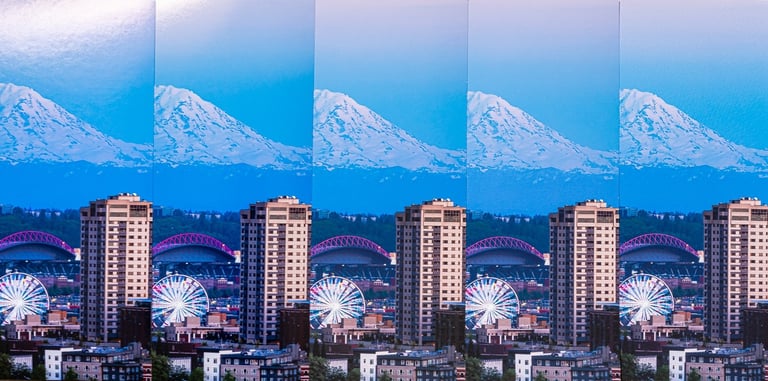

Left to Right: 1) Epson Exhibition Fiber, 2) Epson Premium Luster, 3) Canson Rag Photographique, 4) Epson Hot Press Bright White, 5) Breathing Color Elegance Velvet
The last attribute to consider is white point. White point is related to how the colors present themselves. The OBA treated papers have a bluer cast. The cotton papers have warmer tones.
This can come through in neutral color images. This image from Cape Disappointment is a good example of a neutral color photo.
I tested Canson Rag Photographique side by side with Epson Premium Luster on another image, this autumn shot at Multnomah Falls. I was very happy with the Canson and actually preferred it for this image. The lighter blacks compliment the misty environment.
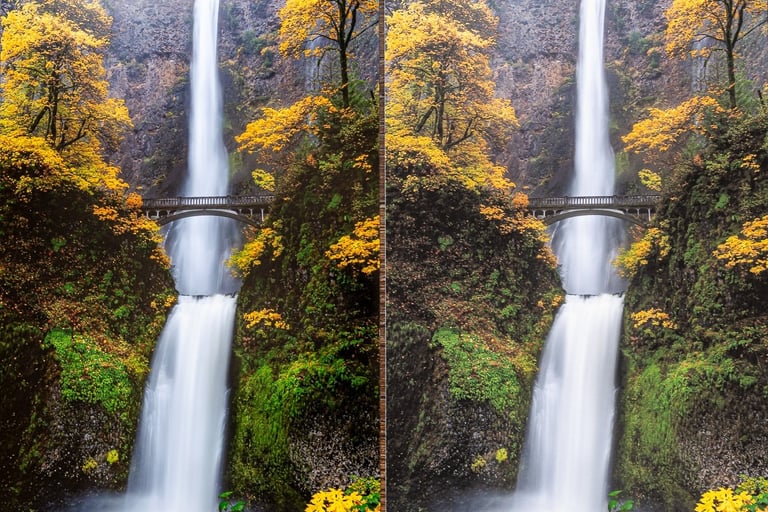

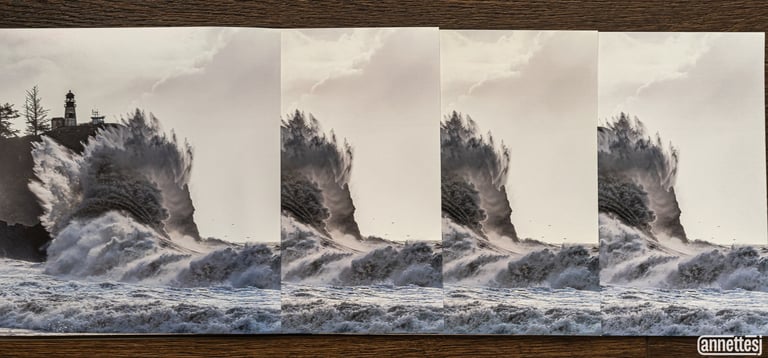

Left to Right: Epson Premium Luster, Canson Rag Photographique, Epson Hot Press Bright White, Moab Entrada Bright Rag
You can see the Epson Premium Luster (OBA treated RC paper) has a cooler cast where the cotton papers on the right have a warmer tones. However, I think all the cotton papers evaluated performed well with this neutral toned image where bright colors are less critical.
Why I Didn't Include Two of the Paper Options
I did not include Epson Hot Press Bright White or Moab Entrada Bright Rag in my recommendations. While these papers are acid free, they do still contain some amount of OBA's. They did not display bright colors as well as the Canson Rag Photographique, which is museum grade and OBA free. All of the cotton papers looked equally nice with neutral images. I therefore did not see any advantage to including Epson Hot Press and Moab Entrada and removed them from my site offerings. Ultimately, I think less options will equal less confusion.
But perhaps the bigger reason for removing them was the realization that just because these offerings are available on Smug Mug, that does not mean I have to sell them. You do have the ability to remove offerings and tailor what is available on your site. If you have your own site or are pondering creating one, hopefully this is helpful advice to you.
Conclusion
I hope this was helpful to you, whether you are here to buy prints or perhaps learn about options for printing your own photos. If you have any questions, feel free to email me at annettesjphoto@gmail.com. If you enjoyed this blog and would like to stay up to date, sign up for my newsletter at the link below.
Fine Art Print Paper Type Attributes. *These papers had no explicit statement on being acid free. Based on this and material they are assumed to contain acid.
Left: Epson Premium Luster. Right: Canson Rag Photographique.
Contacts
annette@annettesjphoto.com
Socials
Copyright © 2023-2025 Annette Stiers Jones Photography. All rights reserved.
